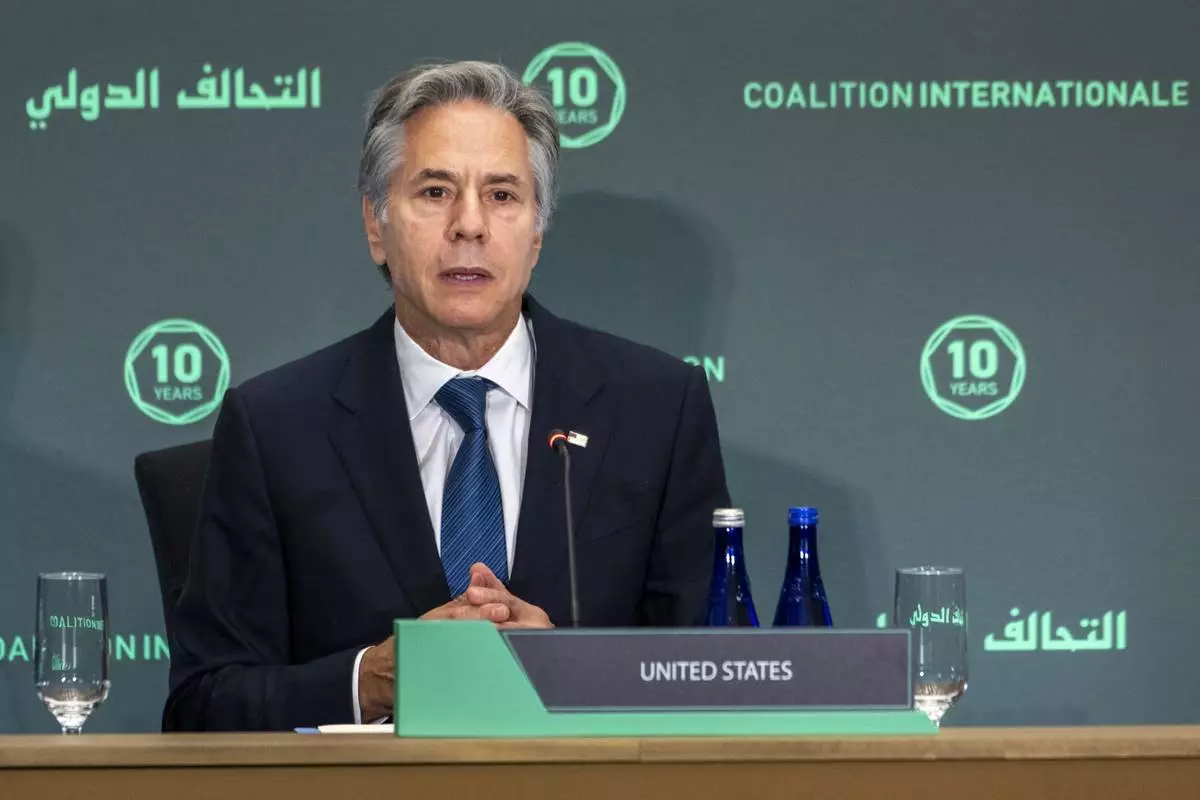WASHINGTON (AP) — Secretary of State Antony Blinken will make his 19th trip in office to Asia this week when he leads the U.S. delegation to a meeting of East Asian leaders in Laos.
The State Department said Tuesday that Blinken would fill in for President Joe Biden at the annual East Asia Summit, hosted by the chair of the Association of Southeast Asian Nations.
Blinken will travel to Laos’ capital, Vientiane, for meetings on Thursday and Friday before returning home. He had been due to join Biden in Germany and Angola over the weekend but the White House announced that the president was postponing his travel due to the severe hurricane weather in the U.S.
Frayed relations with China, particularly over Beijing's increasing assertiveness in the South China Sea regarding territorial disputes with its smaller neighbors, will be a major agenda item for Blinken, said Dan Kritenbrink, the top U.S. diplomat for Asia.
Blinken late last month met with Chinese Foreign Minister Wang Yi on the sidelines of the U.N. General Assembly in New York, but Kritenbrink could not say if Blinken plans to hold separate meetings in Laos with Chinese officials. China will be represented at the summit by Premier Li Qiang.
“A number of (China)-related issues are likely to come up in the context of the ASEAN meetings, including the situation in the South China Sea and China’s continuing to take a number of escalatory and irresponsible steps designed to coerce and pressure many in the South China Sea claimants,” Kritenbrink said.
“Our channels of communication with (China) remain open, and we’ll continue to focus, as we always have, on not just defending U.S. national interests and those of our allies, but also to managing responsibly our competition with China,” he said.

Secretary of State Antony Blinken gives the opening remarks during a meeting of the Global Coalition to Defeat ISIS Ministerial, at the State Department, Monday, Sept. 30, 2024 in Washington. (AP Photo/Kevin Wolf)
ST. MORITZ, Switzerland (AP) — Lindsey Vonn was not about to put everything on the line in her first World Cup race back after more than five years of retirement.
Not with her history of crashes and injuries.
Not with her new titanium knee.
Not at age 40.
Vonn took a low-risk approach and finished 14th in a super-G on Saturday, crossing 1.18 seconds behind Austrian winner Cornelia Huetter.
“This was the perfect start,” Vonn said. “Today is just the first step and I’m not looking for more. Today I really needed to get to the finish. I wanted to have a solid result. And that’s exactly what I did.
“There’s definitely a lot that I have left to give," Vonn added. "Today was not the day to try to do anything special.”
Still, when Vonn came down, the crowd of Swiss-flag-waving fans turned silent in anticipation and all of the other top skiers watched her run on a perfectly clear day in the Alps.
“To have her back on the world stage is just fantastic,” said Sophie Goldschmidt, president and CEO of U.S. Ski and Snowboard. “Just the attention she’s bringing to the sport and the role model she is — it’s a big day.
“These kind of moments transcend outside of just sports. We see it with Mikaela (Shiffrin) and what she’s done recently, which is just superhuman as well, setting all those records."
Vonn lost time early in her run but nearly matched the top finishers in the middle and bottom section of the Corviglia course.
When she reached the finish and saw her time, Vonn flashed a wide smile and waved to the crowd.
“I didn’t risk anything with the line. I was a little bit conservative in some sections, but overall I skied really well. Now I just need my top section to be a little faster and I’ll be in really good shape,” said Vonn, who is planning to race another super-G in St. Moritz on Sunday.
Vonn finished less than a second off the podium, which also included Olympic champion Lara Gut-Behrami in second place, 0.18 behind Huetter, and Sofia Goggia in third, 0.33 back.
“I’m really close to being there," Vonn said. "I’m just not quite there yet.”
Vonn started No. 31 under a new wild card rule for former champions. But that still meant going after all of the current top-ranked skiers had raced.
“The course was a little bit bumpy when I went and so some sections I was a little bit more conservative with my line," she said. “But in some sections I was really fast.”
Vonn had to cut her career short in 2019 due to a series of crashes and injuries, but then she had knee replacement surgery in April and had two titanium pieces inserted into her right knee. Her knee feels better than it has in years, so she decided to come back.
“The last few years of my career were so much different than they are right now," Vonn said. "I’m skiing without thinking about my knee, which I really haven’t done since I first tore my ACL in 2013. So it’s been a long time that I felt this good and I’m a little bit older, but honestly, I’m a hell of a lot stronger than I once was.”
Eight-time overall World Cup champion Marcel Hirscher also took advantage of the wild card rule and returned this season after five years away. But then Hirscher tore his left ACL while training in giant slalom and announced earlier this month that his comeback season was done.
Vonn left the tour with 82 World Cup wins — the record for a woman at the time and within reach of the then all-time Alpine mark of 86 held by Swedish standout Ingemar Stenmark. The women’s record held by Vonn was eclipsed last year by Shiffrin, who now has an outright record 99 wins.
Shiffrin, who shares the record of five wins in St. Moritz with Vonn, isn’t racing this weekend as she recovers from abdominal surgery to clean out a puncture wound she sustained in a crash last month.
Vonn is attempting to enter unchartered territory in terms of success at an advanced age in women’s skiing.
The oldest woman to win a World Cup race was Federica Brignone, the Italian who won the giant slalom in Soelden, Austria, in October to start this season, at age 34.
“It’s super impressive,” said Vonn’s U.S. teammate Jacqueline Wiles, noting that Vonn didn’t have as much preseason preparation as other skiers. “If anybody could do it, she could. The more she gets comfortable and gets kind of back up to speed, she’s going to be right in there.”
So will Vonn charge harder on Sunday?
“Step by step,” Vonn said. “Patience.”
AP skiing: https://apnews.com/hub/alpine-skiing

Sofia Goggia of Italy, left, and Lindsey Vonn of United States of America, talk with journalists after completing an alpine ski, women's World Cup super G, in St. Moritz, Switzerland, Saturday, Dec. 21, 2024. (Jean-Christophe Bott/Keystone via AP)

United States' Lindsey Vonn, takes a selfie in the finish area after completing an alpine ski, women's World Cup super G, in St. Moritz, Switzerland, Saturday, Dec. 21, 2024. (Jean-Christophe Bott/Keystone via AP)

United States' Lindsey Vonn, right, smiles after completing an alpine ski, women's World Cup super G, in St. Moritz, Switzerland, Saturday, Dec. 21, 2024. (Til Buergy/Keystone via AP)

United States' Lindsey Vonn competes in an alpine ski, women's World Cup super G, in St. Moritz, Switzerland, Saturday, Dec. 21, 2024.(Jean-Christophe Bott/Keystone via AP)

United States' Lindsey Vonn, right, smiles after completing an alpine ski, women's World Cup super G, in St. Moritz, Switzerland, Saturday, Dec. 21, 2024. (Til Buergy/Keystone via AP)

Italy's Sofia Goggia, left, hugs United States' Lindsey Vonn after Vonn competed in an alpine ski, women's World Cup super G, in St. Moritz, Switzerland, Saturday, Dec. 21, 2024. (AP Photo/Giovanni Auletta)

United States' Lindsey Vonn celebrates at the finish area of an alpine ski, women's World Cup super G, in St. Moritz, Switzerland, Saturday, Dec. 21, 2024. (AP Photo/Giovanni Auletta)

United States' Lindsey Vonn competes in an alpine ski, women's World Cup super G, in St. Moritz, Switzerland, Saturday, Dec. 21, 2024. (AP Photo/Marco Trovati)

United States' Lindsey Vonn celebrates at the finish area of an alpine ski, women's World Cup super G, in St. Moritz, Switzerland, Saturday, Dec. 21, 2024. (AP Photo/Giovanni Auletta)

United States' Lindsey Vonn, right, is congratulated by Red Bull Head of Athletes Special Projects Patrick Riml after she competed in an alpine ski, women's World Cup super G, in St. Moritz, Switzerland, Saturday, Dec. 21, 2024. (AP Photo/Giovanni Auletta)

United States' Lindsey Vonn celebrates at the finish area of an alpine ski, women's World Cup super G, in St. Moritz, Switzerland, Saturday, Dec. 21, 2024. (AP Photo/Giovanni Auletta)

United States' Lindsey Vonn celebrates at the finish area of an alpine ski, women's World Cup super G, in St. Moritz, Switzerland, Saturday, Dec. 21, 2024. (AP Photo/Giovanni Auletta)

United States' Lindsey Vonn, right, smiles after completing an alpine ski, women's World Cup super G, in St. Moritz, Switzerland, Saturday, Dec. 21, 2024. (Til Buergy/Keystone via AP)

United States' Lindsey Vonn looks on before competing in an alpine ski, women's World Cup super G, in St. Moritz, Switzerland, Saturday, Dec. 21, 2024. (AP Photo/Giovanni Auletta)

United States' Lindsey Vonn looks on before competing in an alpine ski, women's World Cup super G, in St. Moritz, Switzerland, Saturday, Dec. 21, 2024. (AP Photo/Giovanni Auletta)

United States' Lindsey Vonn looks on before competing in an alpine ski, women's World Cup super G, in St. Moritz, Switzerland, Saturday, Dec. 21, 2024. (AP Photo/Giovanni Auletta)

United States' Lindsey Vonn does a course inspection before competing in an alpine ski, women's World Cup super G, in St. Moritz, Switzerland, Saturday, Dec. 21, 2024. (AP Photo/Marco Trovati)

United States' Lindsey Vonn concentrates during the course inspection before competing in an alpine ski, women's World Cup super G, in St. Moritz, Switzerland, Saturday, Dec. 21, 2024. (AP Photo/Marco Trovati)

United States' Lindsey Vonn concentrates during the course inspection before competing in an alpine ski, women's World Cup super G, in St. Moritz, Switzerland, Saturday, Dec. 21, 2024. (AP Photo/Marco Trovati)





























